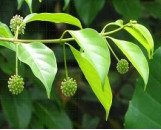Development and Validation of a High-Performance Liquid Chromatography-Based Method for Catechin Isolated from the Leaves of Gambir (Uncaria gambir Roxb) http://www.doi.org/10.26538/tjnpr/v7i3.16
Main Article Content
Abstract
Gambir (Uncaria gambir Roxb) has long been thought to provide various health benefits due to the main secondary metabolite, catechin. The high catechin content makes gambir a strong antioxidant. The present study was conducted to develop and validate the quantification of catechin in gambir leaves by high-performance liquid chromatography (HPLC). The method was performed using a 100 mL sample with dilution. The separation process employed a Sunfire C18 (150 mm × 4.6 mm) column, the mobile phase was composed of solvent A: 0.03% trifluoroacetic acid in acetonitrile-water (5:95) and solvent B: 0.1% trifluoroacetic acid in acetonitrile at a 0.45 mL/min flow rate. The validation was conducted by measuring the accuracy, precision, linearity, limit of detection (LOD), limit of quantification (LOQ), and robustness. The results showed that the percent recovery was 98.30-99.82% with a precision value of 0.28% RSD, good linearity with a 0.9996 R-value, 2.7 µg/mL of LOD, and 8.3 µg/mL of LOQ. There was no significant difference between changes in the mobile phase of 4% (comparison of area and retention time), and 6% (comparison of area). However, the results also demonstrated that the mobile phase was not resistant to changes in the mobile phase of 6% in the ratio of retention time because of the shift in
retention time that was faster than the catechin standard. The findings of this study reveal that this method satisfies the validation requirements for accuracy, precision, linearity, and robustness tests, therefore, the HPLC-based method can be applied to analyze catechin in gambir leaves.
Downloads
Article Details

This work is licensed under a Creative Commons Attribution-NonCommercial-NoDerivatives 4.0 International License.
References
Malik D, Afner SOG, Fukuda A, Masunaga T. Socio economical evaluation of Uncaria gambir cultivation systems in West Sumatra, Indonesia. Tropics. 2020; 29(3):77-87.
Yunarto N, Sulistyowati I, Reswandaru UN, Elya B, Sauriasari R, Konadi L. Inhibitory activity of Uncaria gambir Roxb extract, ethyl acetate fraction, and catechin isolate on lipase. AIP Conf Proc. 2023;2606(1):020011.
Putra E. A Review: Antioxidant Activity and Isolation of Compounds from Gambir (Uncaria gambir Roxb.). Int J Pharm Res App. 2021; 6(4):395-402.
Anggraini T, Asben A. Gambir Quality from West Sumatra Indonesia Processed with Traditional Extraction. IOP Conf
Ser Earth Environ Sci. 2019; 347:1-9.
Ningsih E, Rahayuningsih S. Extraction, Isolation, Characterisation and Antioxidant Activity Assay of Catechin Gambir (Uncaria gambir (Hunter). Roxb. Al-Kimia. 2019; 7(2):177-188.
Yunarto N, Sulistyaningrum N, Kurniatri AA, Elya, B. Gambir (Uncaria gambir Roxb.) as A Potential Alternative Treatment for Hyperlipidemia. Med Lit Pen Kes. 2021; 31(3):183-192.
Nováková L, Svoboda P, Pavlík J. Ultra-high performance liquid chromatography. J Liq Chromatogr. 2017:719-769.
Konieczka P, Namieśnik J. Quality assurance and quality control in the analytical chemical laboratory: a practical approach. CRC Press. 325-369p.
Yunarto N, Sulistyowati I, Addiena Kurniatri A, Aini, N. Effect of Coating on Physical Chemical Characteristics and
Stability of Gambir Leaf Ethyl Acetate Fraction Tablets as Antidyslipidemic Agent. Med Lit Pen Kes. 2017; 27(2):71– 78.
Yunarto N, and Aini N. Effect of purified gambir leaves extract to prevent atherosclerosis in rats. Health Sci J
Indones. 2016; 6(2):105-110.
Kurniatri AA, Sulistyaningrum N, Rustanti L. Purification of catechins from gambir (Uncaria gambir Roxb) extract. Med Lit Pen Kes. 2019; 29(2):153–160.
Prabaningdyah NK, Riyanto S, Rohman A, Siregar C. Application of HPLC and response surface methodology for
simultaneous determination of curcumin and desmethoxy curcumin in curcuma syrup formulation. J Appl Pharm Sci.
; 7(12): 58–64.
Marson BM, Concentino V, Junkert AM, Fachi MM, Vilhena RO, Pontarolo R. Validation of analytical methods in a
pharmaceutical quality system: An overview focused on HPLC methods. Quím Nova. 2020; 43(8):1190-1203.
Sugihartini N, Fudholi A, Pramono S, Sismindari S. Validation of analytical method for assay of epigallocatechin
error with high-performance liquid chromatography. Pharmaciana. 2014; 4(2):39-44.
Das S, Gurupadayya B, Vikram HPR, Shanmukha I, Neogi A, Namitha B. Phytochemical analysis of quercetin, catechol
and tannic acid in ethanol extract of Barleria prionitis Linn leaf by RP-HPLC technique. Trop J Nat Prod Res. 2022; 6(12), 1990–1999.
Indonesian Ministry of Health. Indonesian Herbal Pharmacopoeia. 2nd ed. Jakarta; 2017.
Yunarto N, Reswandaru UN, Sulistyowati I, Prameswari IO, Pinanditi QL, Patadungan TM. Validation of
Spectrophotometry Method for Determination of (+)- Catechin in Ethyl Acetate Fraction of Gambir Extract (Uncaria gambir Roxb.). J Tum Obat Indones. 2021; 14(2):127-136.
Sahu PK, Ramisetti NR, Cecchi T, Swain S, Patro CS, Panda J. An overview of experimental designs in HPLC method
development and validation. J Pharm Biomed Anal. 2018; 147:590-611.
Chaudhari VS, Borkar RM, Murty US, Banerjee S. Analytical method development and validation of reversephase high-performance liquid chromatography (RP-HPLC method for simultaneous quantifications of quercetin and piperine in dual drug-loaded nanostructured lipid carriers. J Pharm Biomed Anal. 2020; 186:113325.
Matić P, Sabljić M, Jakobek L. Validation of spectrophotometric methods for the determination of total
polyphenol and total flavonoid content. J AOAC Int. 2017; 100(6):1795-1803.
Silinski MAR, Uenoyama T, Coleman DP, Blake JC, Thomas BF, Marusich JA, Gahl RF. Analysis of Nicotine and Non-nicotine Tobacco Constituents in Aqueous Smoke/Aerosol Extracts by UHPLC and Ultraperformance Convergence Chromatography-Tandem Mass Spectrometry. Chem Res Toxicol. 2020; 33(12): 2988-3000.
den Uijl MJ, Schoenmakers PJ, Pirok BW, van Bommel MR. Recent applications of retention modeling in liquid
chromatography. J Sep Sci. 2021; 44(1):88-114.


